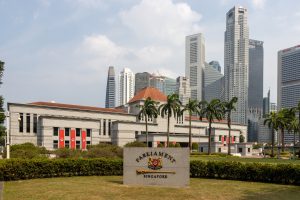Singaporeans will head to the polls for their next general election on May 3, after President Tharman Shanmugaratnam dissolved parliament and issued a writ of election yesterday.
In a statement, Wong’s office announced that April 23 has been set for Nomination Day, when prospective candidates will head to nine nomination centers to file their election registration papers.
In this year’s general election, candidates will contest 97 parliamentary seats, up from 93 at the last general election in 2020, after routine minor adjustments to the city-state’s electoral boundaries. These will be selected from 33 constituencies, including 15 Single Member Constituencies (SMCs) and 18 Group Representation Constituencies (GRCs), in which teams of candidates, usually four or five, compete to be elected rather than individual candidates (as in SMCs). The upcoming election could feature candidates from 11 parties, including two opposition alliances, Channel News Asia reported.
The election is the first to take place under the leadership of Prime Minister Lawrence Wong, who took over from Lee Hsien Loong, the son of founding Prime Minister Lee Kuan Yew, in May of last year. In December, Wong was also named secretary-general of the ruling People’s Action Party (PAP), succeeding Lee.
While the PAP is almost certain to win a hefty majority in Singapore’s tightly managed democratic system, its unbroken control since independence has set a high bar for success. At the last election, which was held amid the COVID-19 pandemic in 2020, the PAP won 61.24 per cent of the votes and 83 of the 93 seats in parliament. However, the party’s support fell 9 percent from the general election of 2015, while the dogged opposition Workers’ Party (WP) won the remaining 10 seats, including the Senkang GRC, its second Group Representation Constituency.
One of the major trends in 2020 was the decline in support for the PAP among younger voters. Surveys conducted after the 2020 poll found that support for the Workers’ Party was highest among those aged 21-25, who were forced to deal with the dire economic outlook and job uncertainty caused by the COVID-19 pandemic. The PAP treated its loss of support almost as a defeat, with senior PAP figures promising to engage in “soul-searching.”
In January, a survey conducted by Blackbox Research’s sentiment tracker SensingSG found that the rising cost of living was the top concern of Singaporean voters, followed by concerns about jobs and unemployment and the quality of government services. “As we edge closer to GE2025, it’s clear that voters are more focused on their own balance sheets than they are on any wider themes,” Blackbox Research founder and CEO David Black said at the time.
This year’s election also takes place in uncertain times, as the world economy reels from U.S. President Donald Trump’s imposition of punitive “reciprocal” tariffs on April 2. In a Facebook post shortly after the writ of election was issued, Wong said that Singaporeans needed to decide who should lead the nation into a world that “is becoming more uncertain, unsettled and even unstable.” He added: “The global conditions that enabled Singapore’s success over the past decades may no longer hold.”
Singapore escaped the worst of Trump’s tariffs, slapped with just the 10 percent baseline tariff that has been imposed on every U.S. trade partner, but Wong nonetheless has described Trump’s move as a turning point – both for Singapore and the international economic order. “The recent ‘Liberation Day’ tariff announcements by the U.S. confirms this stark reality: the era of rules-based globalization and free trade is over,” Wong told Parliament on April 8. “This marks a profound turning point. We are entering a new phase in global affairs – one that is more arbitrary, protectionist, and dangerous.”
All of this suggests that Wong will present voters with a choice between the PAP’s steady economic management, and the uncertainties of change in an increasingly perilous world.

































